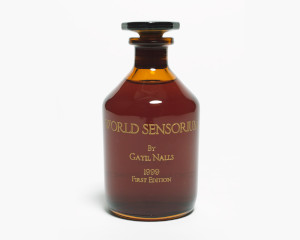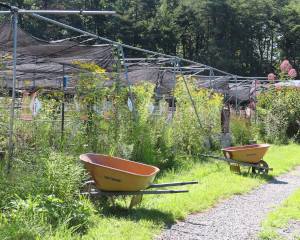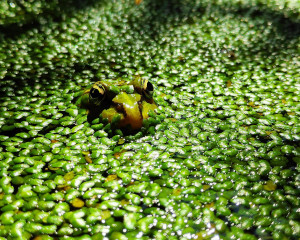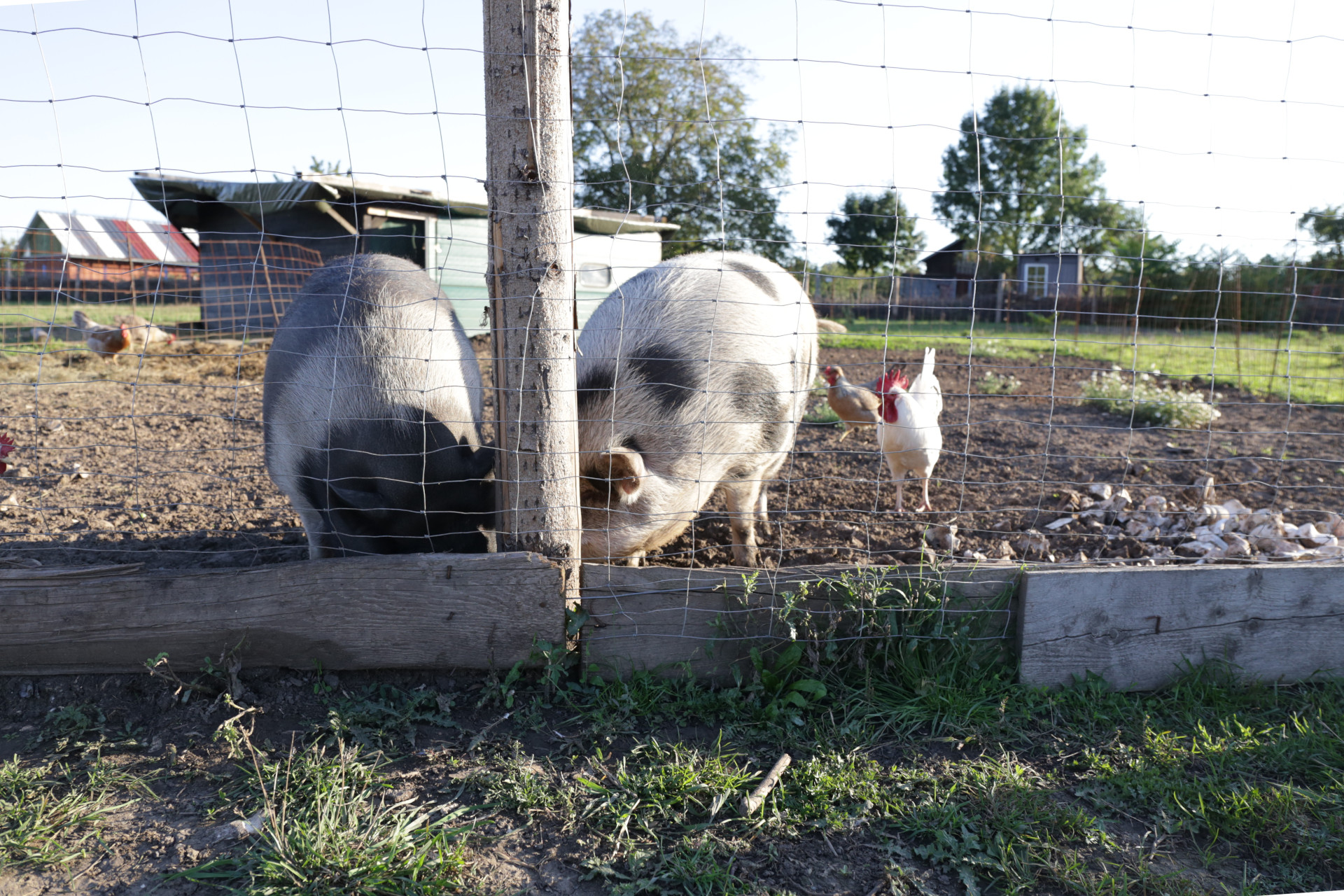
The pigs Frankie and Fífa / Photo credit: Alžběta Procházka
The following is a chapter from Viktorie Hanišová’s book, Beton a hlína [in English: Concrete and Clay], a collection of interviews with individuals practicing eco-friendly and sustainable ways of living in urban environments.
Pigs and Avocados
Marco Stella, Pastvina Community Garden
By Viktorie Hanišová
Sign up for our monthly newsletter!
On the northwestern outskirts of Prague lies a district named Vinoř. Right here, on the site of the prehistoric Nad Obůrkami hillfort, one finds Pastvina, a community garden and animal sanctuary. It feels like being in the backwoods, although we are still within the cadastral boundary of the capital city: there are garden beds with familiar and less familiar crops, the smell of horses, the constant cluck-clucking of chickens and grunting of pigs. A tidy garden it is not. There are things strewn all over: garden tools, wooden boards, tires, and other clutter. Chicken droppings are scattered on the ground and there’s even manure.
It’s here that, going on four years now, gardener Marco Stella has been cultivating the land. For this interview, we sit down in the open “atrium,” which serves as a communal space for the community gardeners. Marco offers me water from the local well. I cautiously ask if it’s potable, as I must admit the environment doesn’t inspire complete trust in me. Marco just makes a face: “Worst case scenario, you’ll get the runs.”
I went to your website and looked at photos of the garden and read up on lots of background, but even so, at first sight I was stunned by the sheer size of the property you are cultivating. It seems huge. How big is your garden?
At the moment I think it’s about four acres, but most of the land is used for grazing. The area where the community garden itself is located, by which I mean the communal garden beds, is about two thousand square meters, with roughly a quarter of a hectare taken up by vegetable beds, and about a third of a hectare by an orchard.
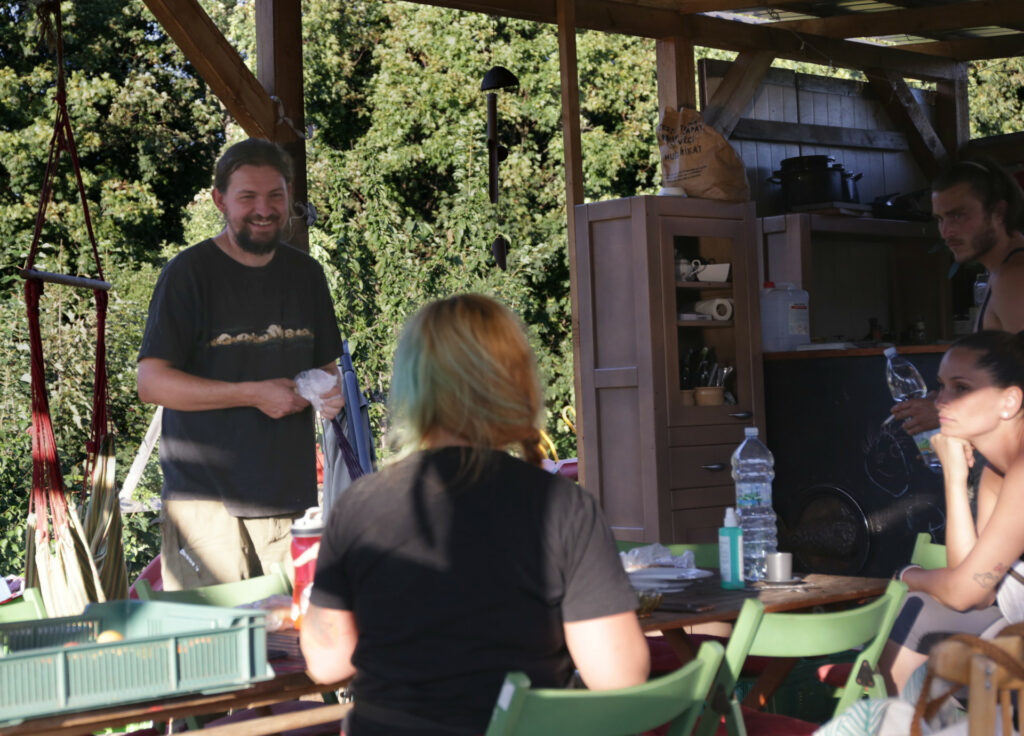
“As I see it, there’s no need for excessive philosophizing, all you need to do is show up, turn over a flower bed or feed the chickens.” / Photo credit: Alžběta Procházka
To whom does the land belong?
Private owners, with some belonging to the town, some to the state, and basically, we take care of it all for free, so it works to everyone’s advantage.
How did Pastvina come into being?
This is our third year here. We started in the spring of 2018, but before then, one very important thing happened. The place where we are now sitting is property that my brother and I inherited from our grandmother. It was originally a field, but for about twelve years nobody did any farming here, so in the meantime it grew into woods. There were five- to six-meter-tall maples, ailanthus trees, and all sorts of bushes. What you see here today is the result of three years of intense grazing. Between me and my girlfriend, who’s still very much the moving spirit of this place, we’re kind of lazy, and we didn’t feel like clearing it by hand. So, we brought over some horses who, in a matter of a few weeks, basically turned the brush into something fairly decent looking that one could walk through. Some plots were loaned to us by neighbors, others we appropriated by squatting, but the grazing happened wherever it could. Except that with horses, you very quickly find out that they produce an awful lot of manure. So, we started to compost the manure in raised beds but found that we had more than we could handle, or at least that’s how it struck me back then. We decided to open the space to the public in the form of a classic community garden. We started with a barren plain, and the only thing we built back then was a windpump that we needed for the horses. Without water we would have been in trouble.
Why is water such an issue here?
We’re in a place where the microclimate is pretty extreme. Since it’s an open plain, it gets terribly hot in the summer. This means we can grow melons, but it makes being here during the day intolerable. It can easily get up to forty-eight degrees Celsius. And then in the winter, it gets bloody cold, because it’s windy and there’s nothing here that holds any heat. Naturally, we’re trying to take measures to mitigate some of these negative effects, we’ve planted a line of trees, we’ve put up fencing made of natural material to create sections with different microclimates, ones that are wetter, for example. Water is of course a problem because we have no natural means to collect it here, so we pump it from a well. On the other hand, there’s a crack right underneath us through which water flows into a natural spring, so there’s plenty of water, except that it’s thirty meters down. Without water you can’t farm, even though I try to keep usage to a minimum and barely do any watering. But if we’re to have any crop yield at all, water is essential, especially for the animals. A crop yield is important to us because we work like a CSA and sell boxes of produce, and that revenue partially finances our operation. Currently we have about fifty members of whom some fifteen are active, meaning they don’t just work on their own plot of land but participate in caring for the animals, helping with repairs, bush-hogging the thistles, or making a purchase for us.
How did you end up with your current space, which is much larger than the property you inherited?
This place is a cultural monument. We are situated on the site of a large hillfort that dates back to the Bronze Age, which has its advantages and disadvantages. Like all hillforts, we sit on top of a hill with a gorgeous view. The disadvantage—depending on how one looks at it—is that there is absolutely no construction permitted and that will never change. One isn’t allowed to build anything that goes deeper than a spade. What this means in practice is that [after the Velvet Revolution in 1989] during restitution, many people got back these bizarre little plots of land that were basically useless. They were jagged and tiny, not even enough room to turn a tractor around, so they just lay fallow and became overgrown with self-seeded thickets, underbrush, and grass. So, when we approached these people, they either couldn’t care less or they were pleased.
And what about the municipal lands?
It just happened to be a lucky time when the municipal board was changing, and property rentals and leases of municipal lands were up for review. The lease the municipality had signed with the farmer here turned out to be so unfavorable that it barely covered the property taxes. That farmer never set foot here anyway, so his lease was terminated, and we planted grass and brought in grazing animals. Besides that, we also planted three hundred and fifty trees, some of which are fruit trees, while others have different uses. The same goes for the public lands, we graze the hillsides, which eliminates the need to bring in guys with bush hogs. The animals do the mowing, and they do a better job because they graze selectively, so the result is more aesthetic.
Was this your vision from the very beginning?
It really took shape along the way. We were trying to figure out what we could do here, but once we got water, it radically expanded the options. Up until then we had to bring water in containers for the horses, which was no fun.
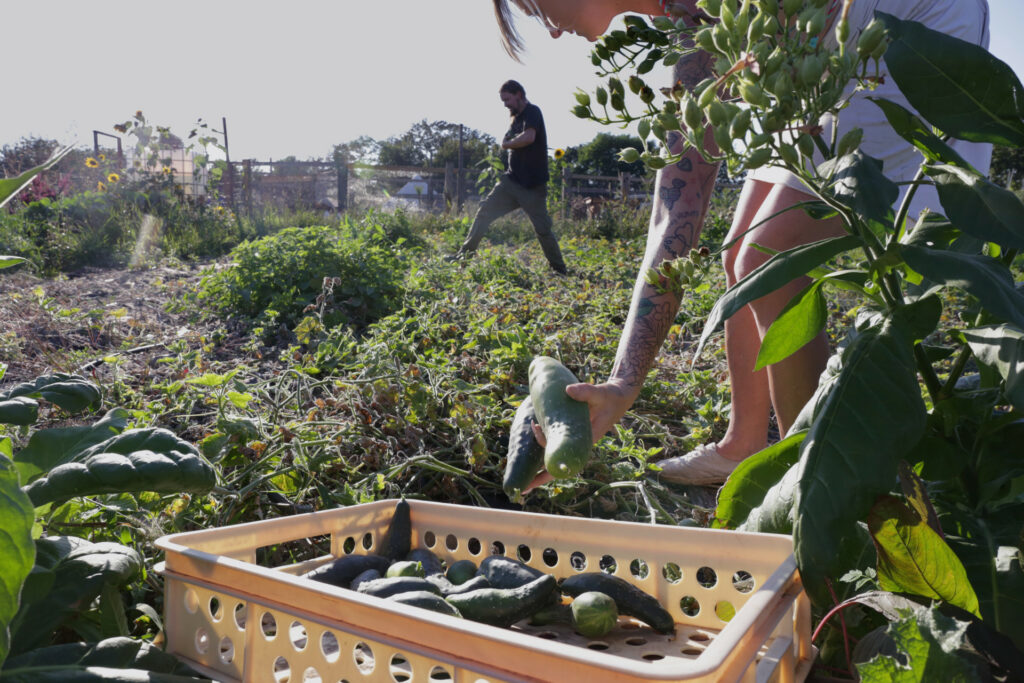
How is your garden organized?
We’re a registered association. I serve as chairman, and we hold an annual meeting for all members, but otherwise we deal with things as they come up. On one hand, I don’t feel like it’s my place to give orders, but on the other, I’m the responsible party, so I appreciate when people do work around here.
Community gardens generally work on two principles. Either the planting is done in a common garden bed and the yield is redistributed, or, more typically, each member manages his or her own garden bed. How does it work here?
We have a combination. Members can either tend their own garden patch of whatever size, since there’s plenty of room, but on condition that they can handle it. The second option is to participate in tending the communal plots. There aren’t too many of those people, though.
Do people who choose the second option have to pay extra?
No. Our membership entry fee is relatively high, but after that there are no other fees. Everything is on a volunteer basis. It may happen, however, that at the rate we’re growing, we’ll have to initiate a monthly membership contribution, because we might have to hire people to help us maintain this place. On the other hand, community gardening is just one of our activities. Another is the CSA, those boxes help support me during the season, and my girlfriend Anička does hippotherapy here, so the horses earn their keep too. There’s also the option of adopting unwanted and retired animals, which is currently our largest source of income, and we host various events, and so on. We definitely have more members who enjoy digging around in their own garden beds than we have active ones.
So, are you financially self-supporting, without grants?
No way. The only grant we received was from the Ministry of the Environment for the planting of lines of trees. What we applied for from the municipality or the Environmental Partnership Foundation either didn’t work out, or we let it go, because compared to the amount of administrative work that’s required, the sums they offer don’t exactly qualify as easy money. As I said, everything here works on a volunteer basis, so if someone wants to invest in our community, either financially or with materials, we write up an agreement with them for an interest-free loan, and then if they want the money back, they pull it out again. These kinds of loans really help us function.
You are one of the few community gardens, maybe the only one, that keeps a large number of animals. Asking entirely as a layperson, of what use are animals to a farm unless they are being raised for meat? What purpose do they serve for the land?
An invaluable purpose. If you want to maintain the land, you can do it with machinery or with grazing. Animals are capable of creating and maintaining biotopes that, without them, couldn’t exist. Take meadows or grazed steppes. Besides, in a temperate zone at least, you can’t do long-term farming without animal manure.
But that’s basically what’s happening these days, people are using artificial fertilizers…
That’s exactly the problem, fertilizers have to be dug up somewhere, which incurs a debt that results in long-term damage to the soil. It’s true that soil has the ability to partially restore its fertility, but its organic components play a big part in helping that along. And when it can’t happen, the soil becomes just a plant-growing substrate into which fertilizer is poured and something grows. Sort of like Keramzit or rockwool, that work like a sponge and can retain nutrients, but then that’s it. In fact, it isn’t even that, because clay aggregate and rockwool both have excellent absorption capacities, whereas dead soil with no organic component has practically none.
How do you get your animals?
Right now, the horses we have come from good stables, but most of the animals that have passed through here came from very bad situations. First, there were abused horses headed for slaughter. Next, I got a hold of ten tormented chickens that were promptly eaten by a fox, so I managed to get some more, and then it occurred to me that, seeing as we had so much land, we could do something good for animals, so we started taking in so-called spent hens from factory farms. In factory farms, hens are replaced, in other words slaughtered, at eighteen months. That’s when hens begin to molt. It takes about six months for a hen to start laying, then it lays eggs for a year, but then around eighteen months the classic brown hybrids start to show a decrease in egg production because they start molting, and in factory farm logic, it doesn’t pay to wait a month or two for them to start laying again, so they knock them off and start from scratch.
So do you have hens from the Chicken Rescue project?
No, we work in parallel.
How so?
Don’t ask.
I’ve heard it’s become a business, that at first those hens were given away practically for nothing, but now the factory farms get paid quite a bit for them, is that so?
Exactly right. We simply do it differently. I’m not about to support factory farms twice. No way am I about to start purchasing these hens from them. The factory farms abuse their hens to begin with, and now I’m supposed to compensate them for slaughtering and liquidating them? They’re just passing the responsibility onto somebody else. For factory farms, these molting hens are just waste. They wheedle one last egg out of them and that’s it.
I remember the first time our children saw these hens in our community garden, they couldn’t recognize what kind of an animal they were. Can you describe these spent hens?
It depends on what kind of a breeding operation they come from, but it’s never good. Usually when they get here their neck and tail feathers are completely plucked out. They do it to themselves from stress and boredom, especially the caged ones, but what’s even worse is when they do it to each other, which happens in the massive sheds, those sometimes have bloody injuries. And on top of that, factory farms are full of mites and chickens tend to scratch, so you’ve got feathers flying all over the place. That’s why the hens are missing so many feathers. When you’re getting them from factory farms, it’s good to take them from May to August and not in other months, because with so few feathers, they have almost no ability to thermoregulate. Furthermore, at factory farms, they are kept at a steady temperature, so they’re not used to fluctuations. In a factory farm, the fact that the chickens are ugly, bruised, bare, and battered means nothing. Apart from that, the chickens lack all sorts of common behaviors. When we bring them here, we coop them up for a day or two to get them acclimated, and then we open the coop with a big to-do and the chickens—nothing. They have no concept of “outside,” they’re claustrophobic, and it’s only after a few days that they timidly start to venture out. Often, they don’t know how to scratch or peck at greens. It takes them about two months to reach a normal state. And even then, about a tenth of them are too stressed to make it. We have two veterinarians here, so the hens get good care, but some still die.
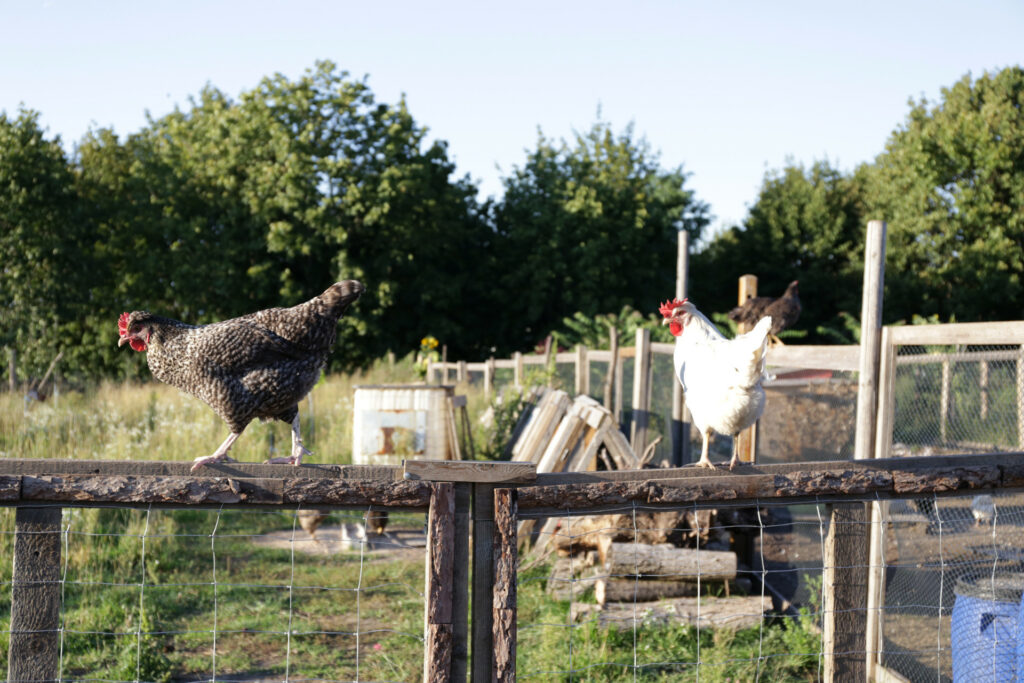
You even have a chicken adoption program here. How does that work?
Someone shows up, picks out a chicken, we put a colored band on it, the person can give it a name, and they get a certificate with its name and information about to whom it belongs. Usually people buy them as gifts, and we’ve also done some crowdfunding campaigns, which are another source of revenue for us. We have chickens here named Pipina, Máňa, Maruška, Olaf, Justýna, Šona, Melasína, Héd’a, Karlička, Helga, Mercedes, Charlie Tango Weiss, Šodó, Bezinka, Mrs. Milínková… We even have chickens named after local representatives of the opposition.
How many chickens do you actually have?
I can’t count them all, but about a hundred and fifty.
Where did you get the horses?
We don’t go looking for them, usually they find their own way here. Someone contacts us to ask if, for a modest fee, we might be able to put up a horse that’s in a bad situation, has behavioral issues or is being picked on because it’s scrawny, and can’t get to the food. Here we’re able to bring it around to a reasonably good condition. Take Jessica, for example, we use her for hippotherapy, she was headed to the slaughterhouse because she was labeled unmanageable, yet here she gives kids pony rides. We have similar experiences with dogs, too. We try not to take in animals just as an act of compassion. Every animal has to earn its keep. We have to calculate if we can afford to feed it and manage the rest, so we end up turning quite a lot of animals away. Something like a llama, for instance, we really don’t need around here.
What other animals are here?
Geese, rabbits, pigs, sheep, and a calf that was tagged for slaughter, because supposedly it had a neurological disorder. For fourteen days it lay in its own excrement and couldn’t even reach the milk bottle. When we brought it here, it looked like a scraggly rabbit, but it ate. We all thought it would die, but because it had big mournful eyes and made sounds like a baby, the women on our committee nursed it along. In the end it turned out not to have a neurological disorder, but a pinched vertebra. All it needed was a good massage. But of course, in factory farm logic it doesn’t pay to massage a calf’s back.
How do rabbits earn their keep?
Just FYI: we don’t eat them. Here’s the thing, the rabbits are a draw for the kids, who then drag over their parents, who then sometimes become members, and every so often even drop us a few pennies. So, it’s basically emotional blackmail. But again, these are animals that somebody found in a trash can or that were an unwanted gift. Sometimes it can be challenging, because parents will bring over an Angora, let’s say, who is one big, bug-eyed dreadlock, and then we have to deal with it.
And the pigs?
Frankie comes from the village next door. He was given to a woman for her fortieth birthday, theoretically as a miniature Vietnamese potbellied pig, but if you feed them, they grow. She lived in a typical suburban little house with a lawn and a hot tub, so within two weeks Frankie turned everything inside out, and he was still little. By the time we got him, he’d been living with a rabbit, and later with some chickens, but now he’s up to a hundred and fifty kilos, so he really can’t live with the chickens anymore. The other pig, Fífa, was running around a housing development in Pilsen.
I assume you probably don’t eat meat…
Sure, I do! But I don’t eat rabbits for obvious reasons. I can’t eat a rabbit who has been adopted by someone, and besides, the kids would have all sorts of curious questions about what happened to the rabbit. Which doesn’t mean, however, that in front of our kids we’re hush-hush about where meat comes from, and that at one time it was running around here. It might sound banal, but a bunch of kids and adults don’t grasp this reality. They think meat comes from the supermarket.
So where do you get your meat? Would you buy meat from a supermarket?
Under no circumstances. I have a network of friends who raise animals in a way that I agree with. We also hatch a lot of chicks here—a bunch are roosters, so of course we eat those, because they would either kill each other or pluck out the hens.
Getting one’s hands on meat that is 100% organic, or even meat that is certified organic, tends to be quite an involved and costly matter.
That’s true, but then I don’t have to eat meat every day, maybe just twice a week.
You wouldn’t even buy eggs at a supermarket?
I have no reason to, and besides, those eggs are disgusting. Granted, one can argue hygiene and that a person could get salmonella, but supermarket eggs are washed in a mild chlorine solution, the same is done to meat, which is soaked in a sterilizing solution to the point that it stinks. But the biggest difference is that the eggs we distribute here to the adoptive parents are at most three days old, whereas the ones you buy in a grocery store could have been sitting there for up to three weeks.
Are you self-sufficient when it comes to food?
I actually don’t know what that means. Theoretically, I do know, but historically, individual food self-sufficiency has never existed. Here we exchange a lot of food stuffs so, for instance, I don’t make my own cheese, but I get it in exchange for eggs, or I swap vegetables for something produced by someone else.
So you never go to the supermarket?
Practically never.
In that case, where do you get foodstuffs that you don’t grow or can’t get through swapping?
There are other tricks for that. We have a division of dumpster divers or, better said, we have some friends who work for a company that distributes cases of very expensive vegetables and other foods that are of premium organic quality and come from all over the world. For example, they’ll get a pallet of avocados in which every third one is very slightly bruised, but because everything has to be of premium quality, these get tossed into a container. We then give them out to those in need, but they come in such a quantity that we can’t use them all, so we feed them to the pigs. But otherwise, we give a lot away, like during the coronavirus crisis, we would leave care packages for the elderly at their front gates.
With avocados?
Not with those, because seniors aren’t familiar with them, so we thought it was better to give them to the pigs.
What would you recommend to an average person who goes to work every day, has a family, and doesn’t have time to go dumpster diving or to grow his own food? What could he or she do to waste less food and live more ecologically?
It strikes me that people from the city have completely lost their sense of seasons and cycles. In the city you can’t really tell what season it is, and you’re not very aware of cyclicity, there’s not much of a difference between day and night, and the cycle of life and death isn’t very visible. Death, whether human or animal, is pushed away and kept out of sight. Another thing is a strange desire for sterility, which we see in some of the people who visit here. A requirement that anything human or social be kept strictly separate from what’s natural. Example: people come out here on a field trip, and a mom lets her kid play in the grass. What she’s familiar with is a close-cropped lawn with no insects or organic remnants. The kid gets stung by a bee, then falls into some chicken poop, and the mom gets upset with us for not having kept things properly separate. People want to enjoy the country, but without smells, blood, and suffering. Like going to the zoo, where everything is behind glass, it doesn’t smell, and you live in the illusion that the animals are just fine, but you don’t see what’s happening behind the scenes. I think the zoo is a good example of how people feel about nature. Even though nature is a word I actually dislike.
It reminds me of those meat packages with a picture of a happy pig.
Yes, that’s exactly it.
Yet some people do live in the city and must live there, so what can they do?
I think it’s good to talk about these illusions. What helps quite a bit is to bite the bullet and go, say, to visit a friend who has “lost it” and is raising sheep somewhere out in the boonies, and spend a full week with him, lock, stock, and barrel. There’s no need for deep philosophical rumination, it’s an experience you can only gain by having it.
And once I’ve had the experience, what can I do? What can my next step be?
This experience results in several things. Firstly: behind every bit of food or nature that is consumed in the city, there is a tremendous amount of time and labor, from which it follows that there is a cost. So, when something is suspiciously cheap, that’s pretty strange. Either the producer is being ripped off, or the product is of a poor quality. Secondly, the experience fosters an awareness of seasonality. There simply won’t be strawberries in November because it’s impossible.
Does it make sense to join a community garden, a CSA, or a community shop?
Some form of active participation, like helping a friend who is a farmer, is appropriate, although for the most part, these types of people do more harm than good. Participating in a CSA is, of course, another way. It strikes me as important not just economically—you are directly supporting a local farmer—but there’s also a social and psychological aspect.
What do you mean when you say those types of people, who go to help out on a farm or in a community garden, do more harm than good?
What’s happened here at times is that we’ll have, say, twenty corporate ladies show up when it’s about 40º Celsius with nothing on their heads, and within half an hour they all pass out. And then what? Or a volunteer shows up in white Converses, gets them dirty, and there’s a problem. People who adopt one of our animals or trees get freaked out because there’s mud. Once we had a man show up in February wearing polished dress shoes to look at a tree, and he got upset and wanted to know why we don’t have sidewalks here.
It’s true that it’s not exactly tidy…
People tend to be surprised, just as you were, to see parts of our garden looking like a dump. The reason is simple—in a certain sense, it is a dump. The same can apply to our animals, plants, and sometimes even people—someone just tossed them away, they didn’t fit in, something, so to say, wasn’t right. This I actually also find fascinating—something works its way through the digestive tract of society, and the moment it falls on the ground, it stops being worthy of attention. Brand new, unused objects, objects with a minor flaw, or even just objects that land in the wrong place at the wrong time, become garbage, something that most people are embarrassed even to think about, let alone find a use for. And just as we recycle the metabolic waste products of our animals and turn them into something beautiful, like a Brussels sprout, almost everything you see here has also been constructed out of waste material from the surrounding neighborhood. Where you may look at a demolished house and see a mess, I see building material. Where you see a worn tire, I see an object with a thousand and one potential uses. Right now, most of the plant material you see here, like branches from cuttings, leaves, and grass clippings, comes from Vinoř and ends up here instead of at some composting center or in a ditch. We then give it a purpose and complete the natural cycle. We try to work with people in a similar way, although with mixed results, but that’s for a longer and sadder conversation.
Aside from this, what do you do for a living? Do you have a profession?
Theoretically, I’m a translator from English and German. But right now, with all this fun and games in the garden, the last thing I want to do when I get home at half past nine is to sit down at my computer and start translating.
So, during the season, you’re here all day and every day working?
Of course, there’s always something to do.
Do you think this garden would have come into being if you hadn’t inherited the field?
Probably not. To me the scariest people in the world are those with a plan. Personally, how I try to function is by exploring opportunities that come out of the situation in which I currently find myself. Naturally, I have a vision of what direction things should go, but I don’t force the issue.
Were you previously interested in ecologically conscious animal husbandry and farming?
In a certain respect. I’m an anthropologist by training, and I’ve dabbled a bit in biology, so there’s an affinity. From an anthropological point of view, I’ve always been interested in the relationship between society and nature, as well as in how this dichotomy came into being. We’re used to thinking of them as two separate realms and we’re not open to the possibility that it isn’t the case. Take the muddied Converses. It’s not as though you’ve got the Converses on one side and the mud on the other, they’re simply dirty Converses. Besides, I have a garden at my house here in Vinoř that I’ve been cultivating for the last ten years using permaculture, a form of long-term sustainable farming in which philosophy and activism partially overlap. So yes, in that respect I was involved with it previously, although it’s really here that it’s been actualized.
Do you get the feeling that people who come to garden here see a greater meaning in it?
As I see it, there’s no need for excessive philosophizing, all you need to do is show up, turn over a flower bed or feed the chickens. I think that gardening failures are actually more important than gardening successes, because that’s how a person learns. That’s where one can see that an individual is an important player who has a significant impact on shaping his environment. Individuals play a much larger role in the world than they think. We live in a world where everything appears to run smoothly and automatically, so a person doesn’t take into account that farming works on debt, and thinks he has nothing to do with any of what’s happening and is thus absolved from responsibility. Nonsense. It’s because people aren’t thinking about what’s going on around them that they transfer the responsibility to, say, factory farms. They just see the attractive packaging at the supermarket and don’t bother to address what’s behind it.
Do you suffer with eco-grief?
I don’t think so. Example: we’re in the Polabí region, an agriculturally exploited, for the most part, hideous landscape, in which, at first glance, there appears to be nothing. Yet here on this tiny spot that we’ve been farming, we’ve managed to create something that is better than what was here before. The region can still be fertile and at the same time, if not attractive, then at least interesting and a gateway for people. Take a field of wheat that’s been sprayed six times, and all it’s going to give you is a rash—nobody is going to set foot there, but they will come here. This is why I don’t suffer from eco-grief, because I think there are places where the environment doesn’t need protection, since there’s nothing left to protect, but where it’s possible to create a new environment. With this area here, I like to say that we terra-formed it, because it was a wasteland, and in just three years, it took on a life of its own. I think the cause of eco-grief is helplessness, a feeling that an individual is powerless. And that isn’t true. Who but an individual can do something? You can’t do away with responsibility that easily. After all, corporations and the state are also just individuals who have banded together. That’s not to say that things aren’t messed up and that we have no reason to fear the devastation of our ecosystem, but there’s still something to be done about it.
The Pastvina community garden is one of the largest projects of its kind in the Czech Republic [pastvina is the Czech word for pasture]. It offers its members communal garden beds as well as the option of leasing plots for growing vegetables and fruit. In addition, it organizes tree plantings, discussions, festivities, and runs a day camp, along with a host of other activities. What distinguishes it from other community gardens is that it keeps a large number of animals on its property: horses, sheep, pigs, chickens, geese, dogs, cats, and Indian Runner ducks.
(English translation by Véronique Firkusny, 2022)
Viktorie Hanišova is a Czech writer and translator. Since her first novel debuted in 2015, she has written five books. She writes themes of sustainable living, motherhood, and the stresses of contemporary lifestyles. Her works have been published internationally in numerous languages.

As Ireland transitions from the rich, smoky scent of peat-burning to a more sustainable future, its olfactory heritage is evolving. What will become the next iconic aromatic symbol of Ireland?
Click to watch the documentary trailer.


